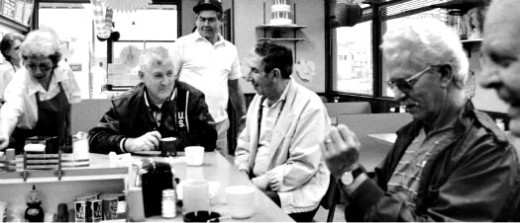Read an excerpt from this article below. You can download the full article by using the link at the end of the excerpt.
What suburbia cries for are the means for people to gather easily, inexpensively, regularly, and pleasurably — a “place on the corner,” real life alternatives to television, easy escapes from the cabin fever of marriage and family life that do not necessitate getting into an automobile.
“Third Places”
Most needed are those “third places” which lend a public balance to the increased privatization of home life. Third places are nothing more than informal public gathering places. The phrase “third places” derives from considering our homes to be the “first” places in our lives, and our work places the “second.”
Americans long enjoyed third places in the form of the inns and ordinaries of colonial society, then as the saloons and general stores springing up with westward expansion. Later came the candy stores, soda fountains, coffee shops, diners, etc. which, along with the local post office, were conveniently located and provided the social anchors of community life.

“Third places” also suggest the stability of the tripod in contrast to the relative instability of the bipod. Life without community has produced, for many, a life style consisting mainly of a home-to-work-and-back-again shuttle. Social well-being and psychological health depend upon community. It is no coincidence that the “helping professions” became a major industry in the United States as suburban planning helped destroy local public life and the community support it once lent….
Third places serve many functions, important both to individuals and to the communities they live in:
1. Third places help unify neighborhoods. Where third places are absent we find that people often live in the same vicinity for years without ever getting to know one another. Indeed, the subdivision resident who knows three other families is something of a social gadabout.
Before neighborhood taverns were banished to commercial strips, the average one drew about 80 percent of its trade from within a two-block radius. It served the same function as does the English “local” — creating community where there would otherwise be a regimentation of private dwellings with little interaction between households.
2. Third places also serve as “ports of entry” for visitors and newcomers to the neighborhood. where directions and other information can easily be obtained. For new residents, they provide a means of getting acquainted quickly and learning where things are and how the neighborhood works.
One might have thought that the high rate of residential mobility in our society would have inspired planners to make provision for new residents to get acquainted quickly and easily. With almost a fifth of the population changing residence every year, would it not have made sense to create the means for newcomers to be easily assimilated? Instead, the typical residential district is notable for its absence of public gathering places, offering instead of maze of frequently deserted streets….
End of excerpt
Article continues with consideration of how:
3. Third places are “sorting” areas.
4. Third places can bring youth and adults into association with one another.
5. Third places help care for the neighborhood. 6. Third places foster political debate.
7. Third places help reduce the cost of living.
8. Third places are entertaining.
9. Third places give the gift of friendship.
10. Third places are important for retired people.